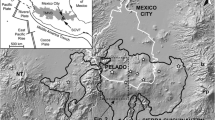Abstract
The sixteenth eruption of Hekla since 1104 began on August 17th, 1980, after the shortest repose period on record, only ten years. The eruption started with a plinian phase and simultaneously lava issued at high rate from a fissure that runs along the Hekla volcanic ridge. The production rate declined rapidly after the first day and the eruption stopped on August 20th. A total of 120 million m3 of lava and about 60 million m3 of airborne tephra were produced during this phase of the activity. In the following seven months steam emissions were observed on the volcano. Activity was renewed on April 9th 1981, and during the following week additional 30 million m3 of lava flowed from a summit crater and crater rows on the north slope.
The lavas and tephra are of uniform intermediate chemical composition similar to that of earlier Hekla lavas. Although the repose time was short the eruptions fit well into the behaviour pattern of earlier eruptions. Distance changes in a geodimeter network established after the eruptions are interpreted as due to inflation of magma reservoirs at 7–8 kilometers depth.
Similar content being viewed by others
References
Fridriksson, S., 1981,Ahrif Hekluelda 1980 a lifrikid. (Ecological effects of the Hekla 1980 eruptions). Tyli,11, p. 19–24.
Kjartansson, E. andGronvold, K., 1983,Location of a Magma Reservoir beneath Hekla Volcano, Iceland. Nature301, p. 139–141.
Nakamura, K., 1977,Volcanoes as Possible Indicators of Tectonic Stress Orientation-Principle and Proposal. J. Volc. Geotherm. Res.,2, p. 1–16.
Oskarsson, N., 1980,The Interaction between Volcanic Gases and Tephra: Fluorine Adhering to Tephra of the 1970 Hekla Eruption. J. Volc. Geotherm. Res.,8, p. 251–266.
Sigvaldason, G.E., 1974,The Petrology of Hekla and the Origin of Silicic Rocks in Iceland. In:The Eruption of Hekla 1947–48, V, p. 1–44. Soc. Sci. Islandica, Reykjavik.
Stefansson, R., Sacks, I.S. andLinde, A.T., 1981,The Hekla Eruption of 1980 — The Mechanism of a Ridge Volcano. Carnegie Inst. yb.,80, p. 511–514.
Sverrisdottir, G., 1982,Ejnasamsetning og eiginleikar gosefna fra Haklu 1980. (Chemical composition and properties of the volcanic products from the 1980 Hekla eruption). University of Iceland, B.Sc. Thesis (unpublished).
Thorarinsson, S., 1967,The Eruptions of Hekla in Historical Times. In:The Eruption of Hekla 1947–48, 1, p. 1–170. Soc. Sci. Islandica, Reykjavik.
————— andSigvaldason, G.E., 1972,The Hekla Eruption of 1970. Bull. Volcanol.,36, p. 1–20.
Author information
Authors and Affiliations
Rights and permissions
About this article
Cite this article
Gronvold, K., Larsen, G., Einarsson, P. et al. The Hekla eruption 1980–1981. Bull Volcanol 46, 349–363 (1983). https://doi.org/10.1007/BF02597770
Received:
Accepted:
Issue Date:
DOI: https://doi.org/10.1007/BF02597770




